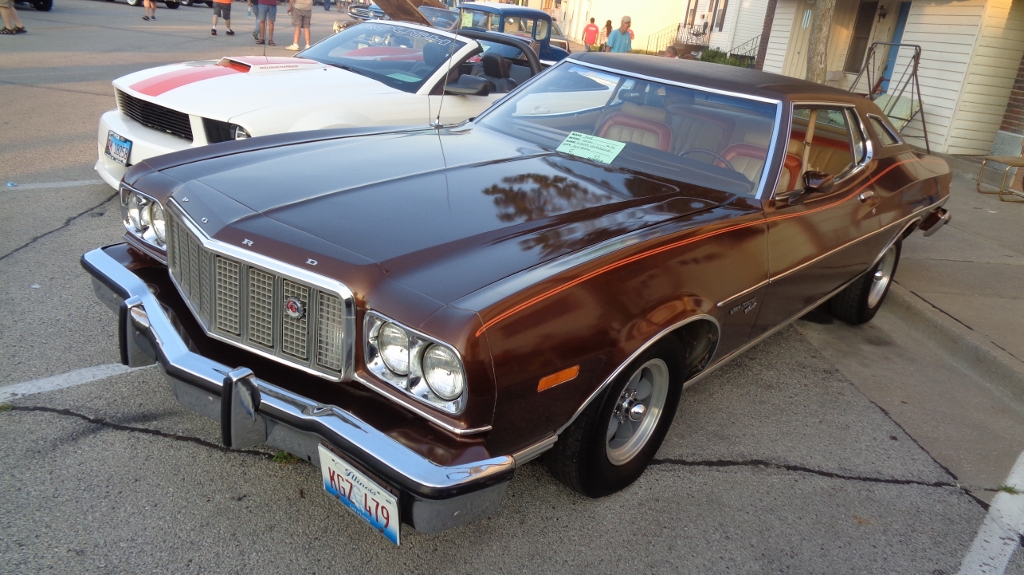
In the 1970s, the watchword for mid-size Ford Motor Company rolling stock was Torino. Gran Torino. Of course, most of us remember a certain Gran Torino made famous on Starsky & Hutch, and who knows how many 1974-1976 Torinos have been saved and restored thanks to that classic detective show? A lot, I’d guess.
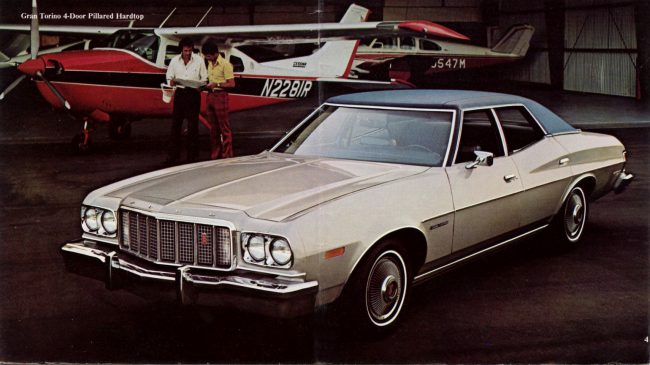
That said, I will assure those whose Torino knowledge is limited to late-’60s fastback Cobra Jets and Detective David Starsky’s tomato-red 460 V8-powered hot rod that most Torinos were not at all like those. Back in the ’70s, your typical Torino shopper wanted comfort and luxury–a smaller LTD Brougham, if you will, and certainly not a muscle car. Today, we’re going to learn about non-TV prepped Gran Torinos that likely made up 90% of Torino production. Sedans and coupes, with 302 V8s and full wheels covers!
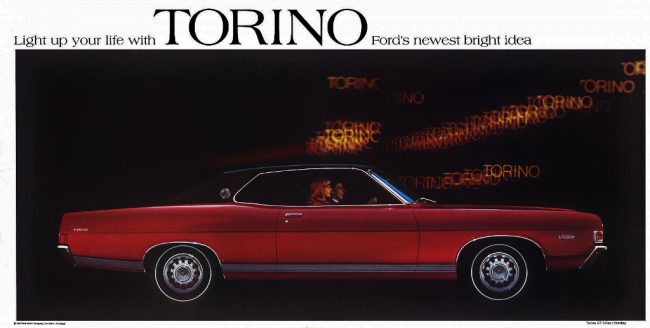
The Torino got its start as part of the restyled 1968 Fairlane lineup. The Torino was the fanciest Fairlane, or in the case of the GT model, the fastest–mid-size Ford. The fastback GT was especially attractive, and had plenty of power to match its looks, provided the right option boxes were checked. My maternal grandfather, Fred Stamp, in a surprising move, traded in his pale yellow 1965 Galaxie 500 pillared sedan on a brand-new ’68 Torino GT hardtop. Red, with black vinyl roof and black interior. Such a sporty coupe was quite out of character for him, but Mom was grateful for it, as she got her driver’s license not long after its arrival.
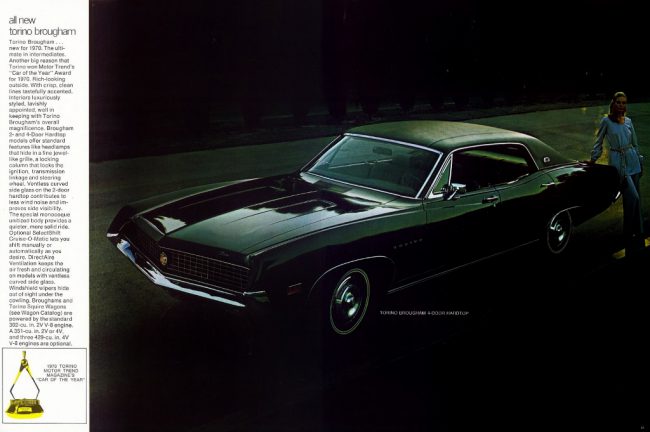
The same basic chassis was restyled for the 1970 model year. By then, the Torino had effectively elbowed out the Fairlane 500 series, which offered only a coupe, a sedan and a wagon. (The Fairlane moniker would disappear completely from the U.S. for 1971, when the Torino 500 series replaced the Fairlane 500.) Every other car in the 14-model 1970 lineup was now badged Torino, including the new, top-of-the-line Torino Brougham. It was, naturally, Broughamtastic, especially in four-door hardtop form.

The mildly restyled 1971 model was the last go-round for the 1968-based body, as well as last call for the speedy Torino Cobra, the GT, and convertibles. Muscle and sportiness were on the way out. Brougham was in like Flynn. And would be for some time.

The Brougham Era, which displaced the Muscle Car Era, which displaced the Pony Car Era, was in full swing in Dearborn, and the arrival of all-new 1972 Torinos further raised the stakes even more. The new Torino and Gran Torino were sized closer than ever to fulsome, full-sized Fords. Sedans and wagons rode a 118-inch wheelbase, and coupes rode a 114″ stretch. The focus was on ride comfort–not on speed or sportiness. By the early ’70s, quietness and smoothness had become the watchwords at Ford, as spurred by the “quieter than a Rolls-Royce” LTD since the 1965 model year.

The new Gran Torino was the highline trim level for 1972 (a Brougham interior option was optional, but did not comprise a stand-alone model). Offered for entry-level buyers was the base-model plain-Jane, non-Gran Torino. As previously mentioned, the GT was now gone, but two new Gran Torino Sport models, a fastback and a hardtop, were available for those who still valued sportiness over Broughamtastic finery.
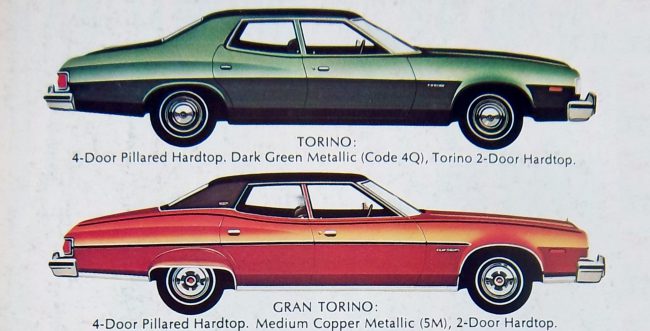
Nineteen seventy-two was the only year you could buy the redesigned model with bumpers as originally envisioned by the design staff. The following model year would bring bulky front bumpers (along with all other ’73 cars) that completely altered the front end’s appearance. Offered as a trim option the previous year, the Brougham now returned as a full-fledged model in 1973–how could it not? Brougham was in, man!
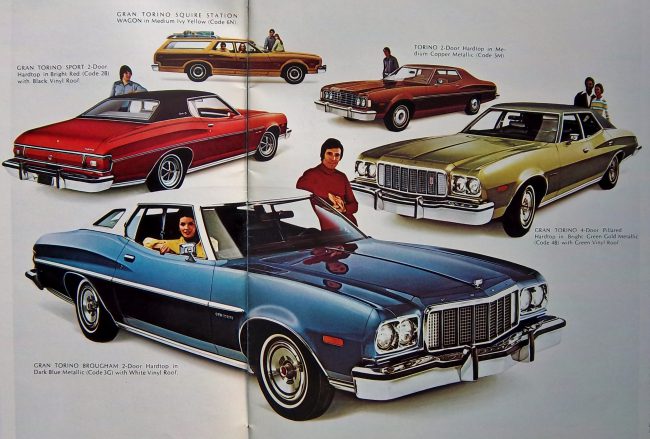
Another face lift greeted Torino shoppers in 1974, as the Gran Torino and Torino received new grilles, a bigger rear bumper, and new taillights that moved from the bumper to the rear sheetmetal. The fastback was gone from the lineup-for good-but you could still get a formal-roofed Sport two-door hardtop.

There was a rental-grade plain Torino, and flossy Brougham model at the other end of the spectrum, but most midsized Torinos were Gran Torino coupes and sedans.

Although very little else was changed for 1975, the base Torino’s unique front fascia was replaced with the fancier Gran Torino nose; probably having realized that tooling different grilles and headlamp surrounds was unnecessary, Ford simply decided to save a few bucks. Standard equipment now included chrome windshield, backlight and drip rail trim, high-back vinyl bench seating and hubcaps. Also standard was a 351 cu in, two-barrel V8 (the previously standard 302 having been relegated to Mavericks and Granadas) producing 148 hp at 3,800 rpm, along with a “three-on-the-tree” manual transmission. Because most retail customers didn’t want something as spartan as the base Torino, only 22,928 sedan, 13,394 coupe and 13,291 wagon versions were built that year. The real money–and volume–could be found in Gran Torino Land.
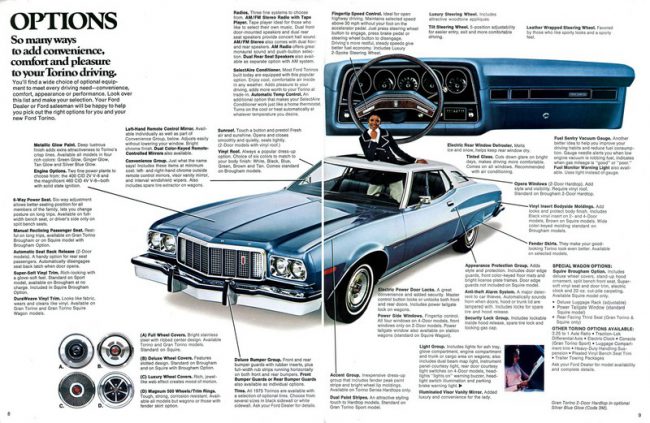
If you wanted something more than a fleet-duty special, the Gran Torino was your car. It was much better equipped, with standard front disc brakes (power assist was optional), upgraded cloth and vinyl seating, carpeting instead of rubber floor mats, and lots more chrome exterior trim.
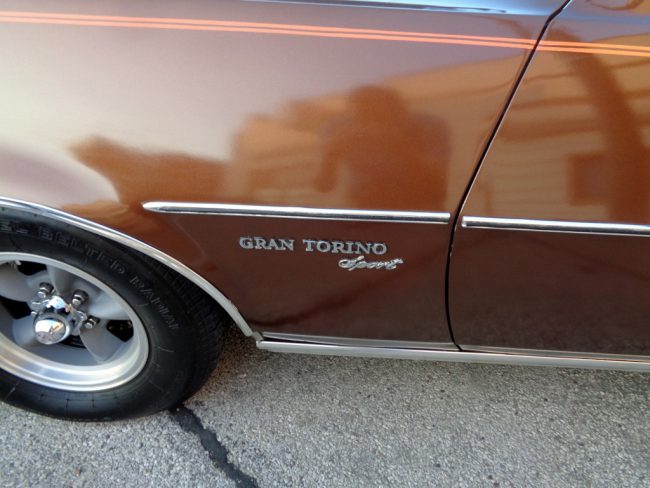
The Gran Torino was the most popular Torino model in 1975, with 53,161 sedans, 35,324 coupes and 23,951 station wagons sold. (The personal-luxury Elite was badged as a Gran Torino in 1974. It became simply “Elite” for 1975-76, but technically remained part of the Torino series.)

Engine options were limited to a two-barrel, 158-hp, 400 cu in V8 (priced at $5.00), and a 218-hp, 460 cu in V8 with four-barrel carb that went for a whopping $245.00 extra.
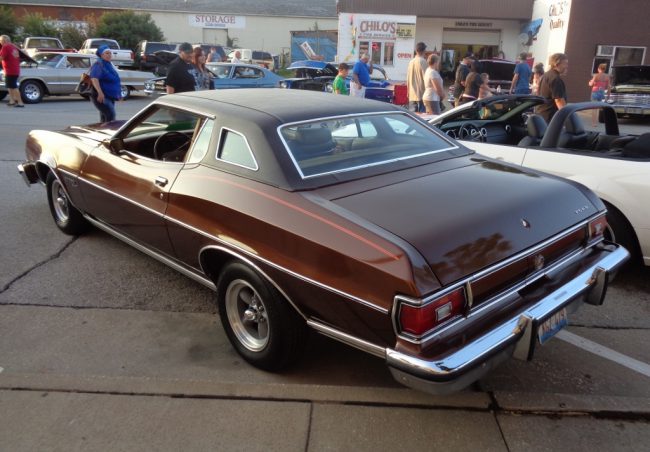
The Gran Torino Sport returned for 1975. With only 5,126 buyers, it might well have been the least-frequently seen Torino. Our root beet brown metallic model seen here was spotted by yours truly at the annual downtown East Moline, IL show back in August of 2017. Other than the faux-Bullitt alloy wheels, it was as stock as the day it was sold new. The lone Sport model was a two-door hardtop that featured special badging, turbine-style wheel covers (obviously missing on this example), color-keyed sport mirrors, and full instrumentation–including a tachometer.

Torino and Gran Torino station wagons offered the same engine selections as the rest of the lineup. They were available in three flavors: Torino, Gran Torino, and Gran Torino Squire. If the Di-Noc-sided Squire was not enough, you could equip it with the Squire Brougham option, which got you seats from the Gran Torino Brougham sedan and coupe, although in vinyl only.
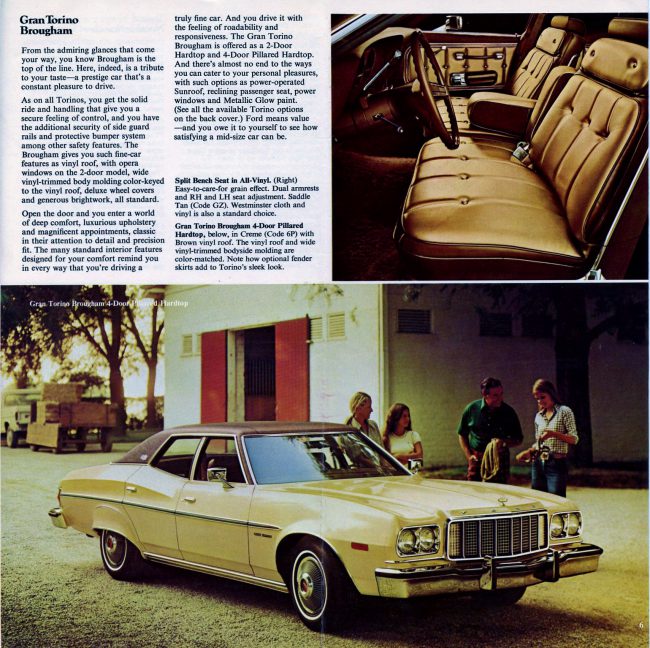
Also included were that all-important stand-up hood ornament, deluxe wheel covers, electric clock and whitewall radial tires. If Ford was known as the Wagonmaster, it was mostly thanks to their full-size LTD and Country Squire wagons. While Torino wagons sold rather well in 1972-73, they were not seen nearly as frequently by the mid-’70s. In 1975, 37,242 Torino wagons were produced, versus over 95K full-size Ford wagons.. Ford was the Wagonmaster back then, but primarily in the full-sized market.
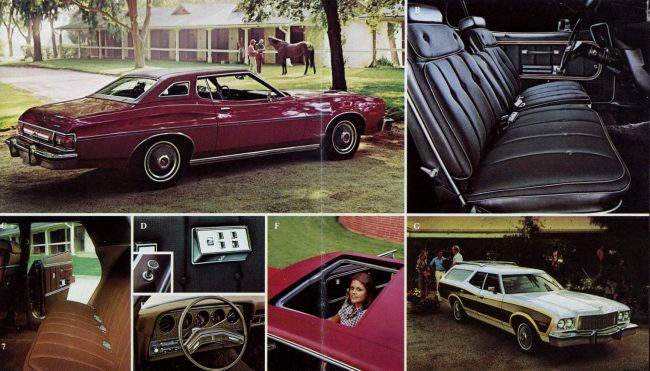
At the top of the ’75 Torino heap again was the Brougham. Available only as a coupe or sedan (Brougham option Squire wagon notwithstanding), a Brougham cost about $500 more than a “standard” Gran Torino. The easiest way to spot a Brougham was by its exclusive stand-up hood ornament.

The expected flossier interior was available in your choice of Westminster cloth or all-vinyl. But like this ’75 Sport, two-tone upholstery in glove-vinyl trim was pretty snazzy too.
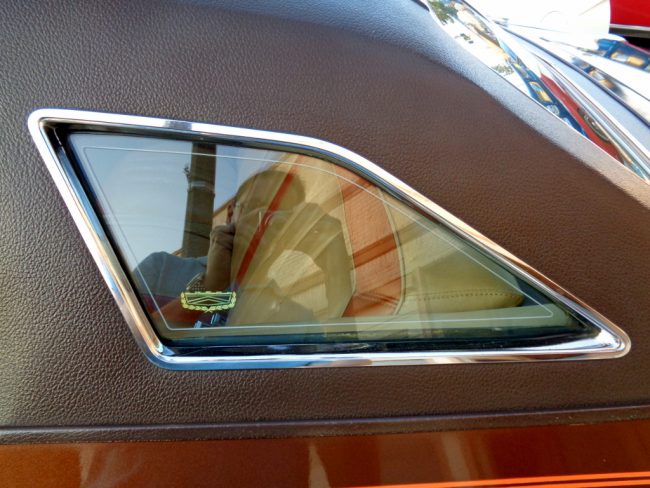
Standard on Brougham coupes was an opera window, inset into the C-pillar, that was optionally available on lesser Torinos, such as this Sport.
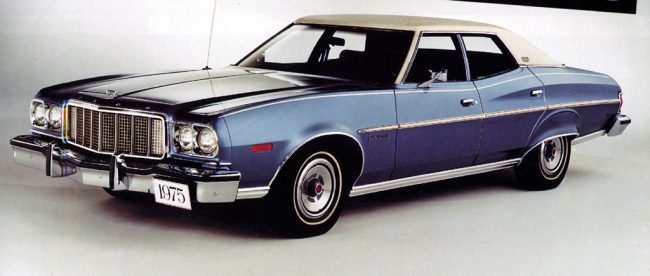
Broughams also got standard power front disc brakes, power steering, bodyside moldings, a padded vinyl roof and, of course, the obligatory hood ornament.

Brougham identification was located within the opera window glass on coupes, and on via chrome C-pillar emblem on sedans. The Brougham series sold decently enough at its 1974 reintroduction, with 11,464 sedans and 26,402 coupes finding buyers, but demand went off a cliff in 1975; only 5,929 sedans and 4,849 coupes found homes. Guess everyone wanted an LTD?

But my guess is that most of the Ford faithful chose the new-for-1975 Granada over the Torino. Although a smaller car, the Granada was much more space efficient, and the uplevel Ghia model did the Brougham treatment just as well as the Gran Torino Brougham–and for less money. In fact, the whole Granada line blew the Torino out of the water, to the tune of 302,658 to 177,953. Even if you include the Torino-based Elite, 1,333 more Granadas were sold, despite the lack of a station wagon model.
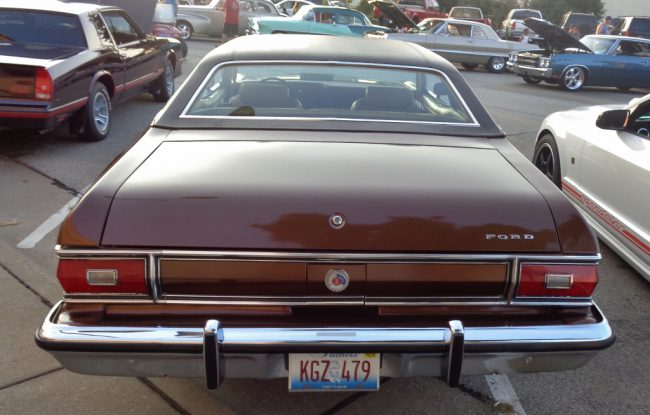
But back to the Torino. Whatever model you chose, there were plenty of options available to personalize your Gran Isolation Chamber. In addition to the aforementioned engine choices, other options included an AM radio ($54), AM/FM stereo radio ($217), vinyl roof ($96), A/C ($426) and whitewall tires ($33). You could even take your pick of several wheel covers, including the still available, always-cool Magnum 500 wheels–but please, please don’t order them with the fender skirts!
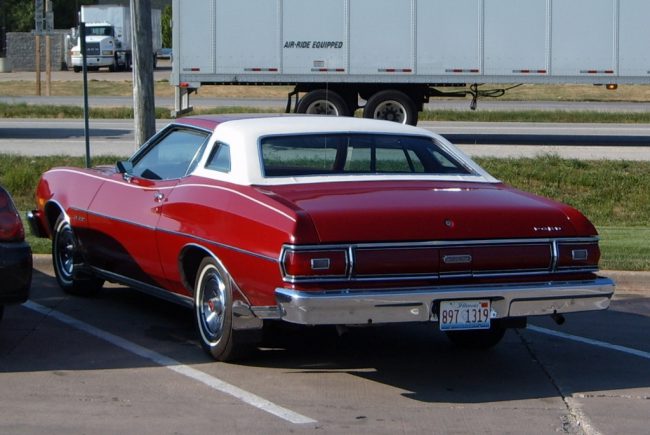
After 1976, the Torino name was no more. The car, however, got fresh sheetmetal and a new LTD II moniker, and carried on through 1979.
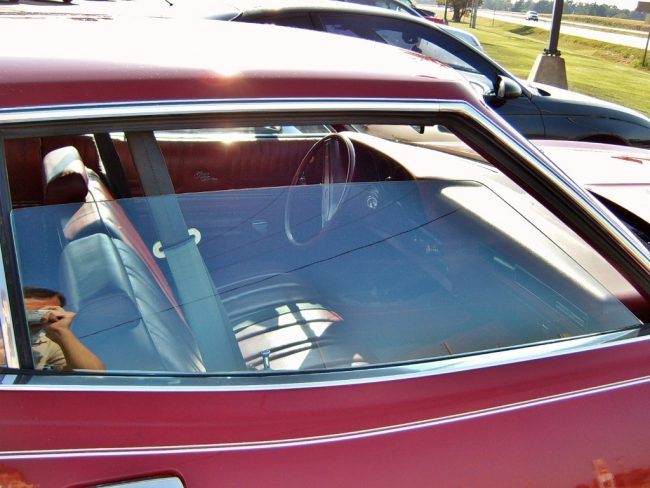
The red car featured here is a 1975 or 1976 Model 65D Gran Torino coupe. I spotted it in a fast food restaurant parking lot in Monmouth, IL, on my way to the 1000+ car Maple City Cruise Night back in August of 2012. Initially I passed it by, thinking I’d see it at the show. However, after a few moments of internal debate, I turned around and went back. Good thing I did, because it wasn’t at the show. You just never know.
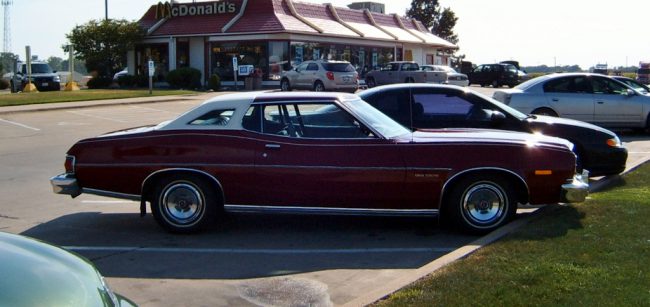
This car would have sold for $4,234 new, but the full wheel covers, whitewalls, landau vinyl roof, pinstriping, side moldings and bumper guards would have added to the tally. The red paint and red interior with white top and whitewalls were pretty snazzy in your author’s opinion.
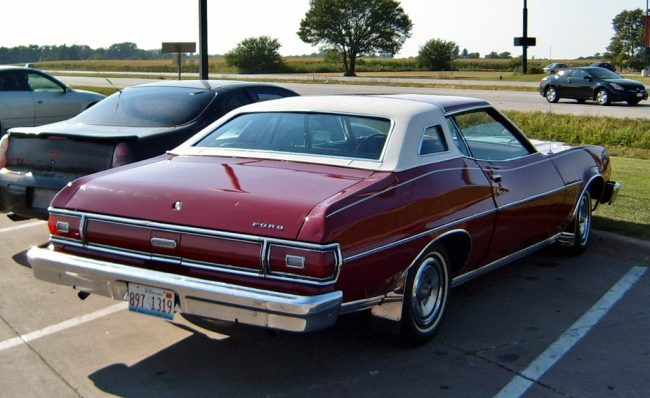
It was in exceedingly nice shape! These cars have all but disappeared, at least in non-Starsky and Hutch tribute form.

Just as I was backing out of the parking spot, the owner and his wife/significant other came out and got into their time capsule from 1975. I had time to lower my window and say “Nice car!” and they waved, but seemed to be in a hurry. I hope they know they’ve got a great Torino. Or, rather, a Gran Torino, haha!







15 Comments
The Granada seems so much more in keeping with the times. The real strippos were still Mavericks which kept the Granada name premium. Also letting the Torino get so heavy that the six was dropped was a big mistake. The big advantage in offering the Torino and LTD II was that it provided a platform for the profitable Tbird and the Mark V that were at their sales zenith.
I find it interesting that the wagon demand dropped below sea level – for what was essentially the same model as was so-well accepted in 1972-3. The only big change happened with the bumper laws in 1973, and that didn’t slake demand – fuel economy was terrible in 1972 and remained so. The economy was slipping into stagflation, but station wagons were suburban workhorses. Flashy tire-burners would suddenly become luxuries, but the kiddies remain in need of portage.
Perhaps that was it. The Baby Boom years ended, by demographers’ line, in 1964; and around 1975 or thereabouts, would be more independent. Bicycle, big-brother/sister, and then their own cars. The next crop of parents would start out with used Bloatwagons; and then gravitate to Fairmont and K wagons. On their way, of course, to Minivan Meadows. And then to the SUV hills.
Interesting. I have intimate experience with this line of cars – the family fleet contained a Gran Torino, 1973, Broughamed before Brougham was a model. Four-door “Pillared Hardtop” – with the 1970s-mandated vinyl roof. The car was a solid, quiet, warm cocoon in which to arrive where you were needed or sent; but the pleasure was strictly the passengers’. He who drove and/or forked over for the fuel, had little joy.
I learned to drive on it, and on a Kaiser Jeep Wagoneer. I preferred the Wagoneer, frankly – although it was no great road car.
Ah, but the style. That alone was almost worth the price of admission…the winner, to me, was (gauche taste that I have) the Ranchero. In those days the F150 was a truck, rode like a truck, was sold as a truck. No one with a dress shirt would ever climb in. The Ranchero, even in the soft-spring Torino days, would have been a better handler (not saying much) and one HELL of a looker.
The local Ford agency was two blocks from my childhood home; I walked by it to high school every day. Forlorn and forgotten on the lost, was an unsold 1972 Ranchero – with the original face. It stayed there, moved from place to place, until 1974. Not a porter rig; just an unsold vehicle; entry-level trim. Bright red with no chrome and probably no air conditioning; and no…body…loved…it.
I wanted that thing SO…BAD…
Too bad they took a reasonably good looking car and turned it into the nasty LTD-II.
Cubism was the new design language of the time. VW Dasher and Rabbit; the crisp new Datsuns. In the pipeline was the Omnirison. The Granada was a bigger sales hit than I’d have expected; and the New Chevrolet (1977 B-body) set records.
And Ford was going through money troubles – the emissions regs were a hard nut to crack with the available technology. So, for better or worse, they were stuck with the old Torino/Montego body…they cubed up the Montego version as best they could, gave it bladed fenders, front and rear; did their best with the railroad-crosstie bumpers, and sent it out.
It didn’t do so well, but interestingly, the new Thunderbird, which was uncomfortably close to it, set even more sales records. Sometimes there’s no explaining buyer preferences.
but it was only one change which ruined it. the ’76 Elite wasn’t exactly “gorgeous,” but it didn’t stick out as ugly either. When they turned it into the LTD II the next year, the front clip was almost the same; same bumper, slightly reshaped grille, slightly different turn signals. But for some reason the stacked rectangular headlamps took it from the “eh” Elite to “barf.”
I don’t think I’ve seen any car from any era that I thought looked good with stacked headlamps, but the LTD II was the absolute worst.
(no edit)
to me, the only members of the intermediates of those years are the ’74-76 Gran Torino, and the ’74-76 Cougar. The Cougar may have just been a gussied-up Torino/Elite, but at least it still looked like a Mercury.
Stacked rectangular headlights were the fad of the times. A car had to have them to be modern, ya know? Like amber dedicated rear turn-signal lenses a few years later. Like LED tail-lights, now.
They looked ridiculous, and were used in some questionable applications. The Plymouth Fury (intermediate) which was the cop-car staple, had them – and if you remember, the optics on those small rectangular sealed beams were TERRIBLE.
Ford, ChryCo, AMC…all did that. Not their best move. I agree that the LTD II would have gone out better as a Torino II with the Elite front clip; but hindsight is 20/20 and today’s tastes are not those of that era.
Nice examples and write-up of what had to be one of the most awful cars of the awful 1970s. I had friends who had these and what I remember is their huge size, lack of interior space, terrible handling (understeer began at single-digit speeds), and horrible quality (vinyl bench seats split at the molded seams after 3 years of 30,000 miles whichever came first, rattles galore). The Granada was really a breath of fresh air sanity when added to the Ford line in 1975, but unfortunately they also got Torino like 11-13 mpg. I would also like to know the story about why so many cars that introduced/restyled in 1972-73 were obviously not designed to have the 5 mph bumpers – did Detroit expect the Feds to back off on the standard and then had to hurriedly introduce badly integrated bumpers when they realized their mistaken assumption?
I can speculate on that last. First, lead time was 5 years, in those days. The agitation for Federalized standards for bumpers began about 1969 and only gained weight a few years later in 1971-ish, when (IIRC) Allstate and a couple other insurers joined on the bandwagon.
Perhaps the automakers didn’t think the movement would gain traction. After all, styling was the most-critical feature of cars of this era.
So, they had half-designed 1973 models, and in come bumper standards. There was no choice with GM’s new intermediates – just slap on the bumpers. The new 1972 Torino was well along, and had what Ford’s people surely thought was inspired styling, and so it was sent out – take advantage of the one year left that it was permissible.
More than anything, I think the bumper standards of those years were responsible for the block-like appearance of cars designed about that time. If you have to have that chromed bar on each end, it looks much better on something like the Granada than it does on a adapted Coke-bottle design.
the point of the bumper standards was to protect the lights in low-speed collisions. if you had a model which had the lights all the way out at the corners (like the maverick and comet) then your only options were to either re-design the entire front end of the car, or put a battering ram up there with a huge gap between the bumper and lights/grille.
the battering ram was cheaper on certain cars. The worst, of course, were Euro and Japanese cars which had to be made compliant
These Torinos (well, Montegos, but same thing) were a huge part of my life growing up. My father had the first year Montego (1968) and then the first full frame Montego (1972) and then another Montego (1974). He was eyeing up a Cougar XR7 (1978) for my mother when he passed. Many of my family and friends had these mid-sized Ford products, ranging from cheap Torinos to my buddy who was enamored with his Elite.
The Falcon based Torinos and Montegos that were introduced in 1968 were actually decent cars all around, with the exception of rust resistance, but that was a given for most cars in the late 60’s. Good overall size, good space utilization, ran well with sixes and small V8’s and were an absolute ball with a big block (ask me how I know…). The 1972 re-engineer wasn’t great, the cars got heavier, less space efficient and needed bigger engines to move all that mass around. By the time the bumper regs were enforced, the added weight of the battering rams front and back made an already marginal handling car turn into a poor handling car (again, ask me how I know…). IIRC, GM made rear anti-roll bars standard on many of it’s mid sized cars. That didn’t make them Formula 1 cars by any stretch of the imagination, but it did help with the terminal understeer that was dialed in to many of these cars from the factory.
By 1975 these cars defined malaise for me. The adequate 250 six in our 1968 Montego was underpowered in our 1972 Montego and by 1974 the 302 V8 was even worse than the 1972 six cylinder powered car. The cars got bigger, then engines got bigger and the fuel economy went down, down, down. All of the opposite characteristics that people wanted at the time. Our 1974 Montego was delivered with a bunch of nuts and bolts loose in the glove box; after a week we realized that the dashboard had not been properly installed. Back to the dealer it went. Our car was not unique in that regard.
My good friend had a 1975 Elite with the 351 Windsor motor. Compared to other contemporary Torinos and Montegos it was pretty zippy. It wasn’t until his dad bought a 1978 Olds Omega with the Chevy 305 4bbl. That car would smoke the Elite in every way imagined, with the exception of twin opera windows. My brother’s friends’ 1975 VW Rabbit was a revelation in handling and performance. It had close to the same amount of interior space as the Torino models and far more utility with the fold down seats and FWD.
One can see why these cars went out of style.
It’s what effect time has on your memories. Back when these were new I was driving late 1960s era muscle and had total contempt for these ensmogulated, overbumpered and broughhamed coupes with their opera windows, landua roofs and underpowered engines with overweight chassis. I even extended the life of my ’69 Cutlass by rebuilding the engine and doing extensive bodywork to keep it running well into the 1980s rather than drive one of these.
But now I look at these and appreciate their virtues. I wish I could buy a relatively affordable, stylish, quiet riding luxury coupe now. I guess you could say a BMW 6 series qualifies and indeed it’s everything except affordable. Back then you didn’t need to be rich to drive one of these. Compared to the standard issue crossover that everyone is driving these days the people who bought these were indeed riding in style and comfort.
Favorite is the 72 Gran Turino Sport, I know they didn’t have much in the way of actual sport, but the styling was perfect and unique to that year. The 71 looks like a 60’s Cutlass, and the 73 looks like a frumpy Dodge Aspen broughamy midsize. I wonder if the styling with the protruding oval grill was meant to be a response to the new Camaro, but Ford changed their minds because they had a new Mustang in the works.
I have a lot of love in my heart for the Gran Torino – I grew up and learned to drive in a 1973 Gran Torino Sport. Nothing special compared to a few of my high school mates who had hand-me-down muscle cars. But she had a 351 Cleveland with a 4-barrel so I felt some connection to the hairy beasts of old. I own a Challenger Hellcat now but I’d buy a nice Gran Torino if I ran across one. Preferably a ’72 Sport with the hood scoop and “correct” front bumper.
I like the gentle arch of the front fenders on that red ’75/’76. It’s somewhat subtle but given the tendency toward slab-sides and angles of the era it’s quite refreshing.